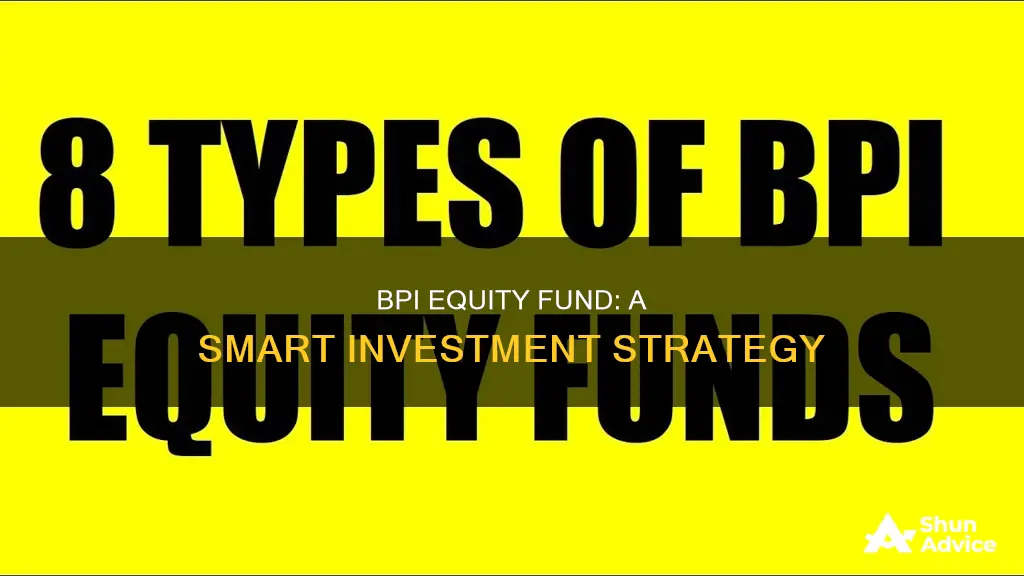
BPI offers a wide range of investment funds, including equity funds, to help you reach your financial goals. Before investing in BPI equity funds, it is important to understand your financial goals and risk tolerance. The BPI Philippine Equity Index Fund, for example, aims to provide investment returns that track the performance of the Philippine Stock Exchange Index (PSEi) by investing in a diversified portfolio of stocks. The fund has a minimum initial investment requirement of PHP 10,000 and a trust fee of 1.00%. You can conveniently open a BPI investment account through the BPI app and explore other investment options, such as Unit Investment Trust Funds, to build a stable portfolio and grow your wealth.
| Characteristics | Values |
|---|---|
| Minimum Initial Investment | PHP 10,000 |
| Minimum Transaction Amount | PHP 1,000 |
| Trust Fee | 1.00% |
| Minimum Holding Period | N/A |
| Early Redemption Penalty | N/A |
| Valuation of the Fund | Marked-to-market daily |
| Subscription Settlement | N/A |
| Redemption Settlement | N/A |
| Recommended Investment Horizon | N/A |
What You'll Learn

Investment risk tolerance
Risk tolerance is an important component of investing in BPI equity funds. It is the degree of risk that an investor is willing to accept, given the potential for losses or gains in the value of their investments. Understanding your risk tolerance will help you choose the most suitable BPI equity fund for your financial goals and situation.
Assessing Your Risk Tolerance
Before investing in BPI equity funds, it is essential to assess your risk tolerance. This involves considering factors such as your financial situation, investment experience, objectives, and tolerance for volatility and potential losses. Here are some key aspects to consider when evaluating your risk tolerance:
- Investment Objective: Are you primarily focused on preserving your principal investment, generating steady income, or achieving significant growth over the medium to long term?
- Investment Horizon: How much of your investment can be allocated to medium or long-term investments, typically those with a duration of more than three years?
- Liquidity: Do you require regular income withdrawals from your investments, or can you reinvest any returns to allow for potential growth?
- Risk Tolerance: How comfortable are you with fluctuations or potential losses in the value of your investments? Are you prepared to accept minimal, moderate, or significant fluctuations to pursue higher returns?
- Reaction to Loss: If your portfolio experiences a significant loss, such as a 20% decrease in value in one year, how would you react? Would you be concerned and seek safer investment options, or would you remain calm and focus on long-term growth?
- Net Worth: Understanding your average net worth over the past few years provides context for your risk tolerance. Those with higher net worth may have more flexibility to take on riskier investments.
- Investment Knowledge and Experience: Assess your knowledge of different investment types and your experience in investing directly or through a fund manager. This experience can help you make more informed decisions about risk.
Types of Risk Tolerance and BPI Equity Funds
BPI offers a range of equity funds that cater to different risk tolerances:
- Moderately Conservative Funds: These funds are for investors with a moderately conservative risk profile. They typically aim for modest growth while managing risks. While these funds prioritize capital preservation, meeting long-term goals may be challenging due to the potential for lower returns. Examples include the BPI Money Market Fund and the BPI US Dollar Short-Term Fund.
- Moderately Aggressive Funds: These funds are designed for investors who want to increase the value of their portfolio while being cautious about the risk of minor losses. They aim for capital appreciation and income generation. Examples include the BPI Sustainable Global Bond Fund-of-Funds and the Odyssey Peso Medium-Term Bond Fund.
- Aggressive Funds: Aggressive funds are for investors with a high-risk tolerance who seek significant growth and are prepared to take higher risks for the potential of higher returns. Examples include the BPI Philippine High Dividend Equity Fund and the BPI Philippine Equity Index Fund.
Index Funds: Risky Business or Smart Investing?
You may want to see also

Investment account opening
To open an investment account with BPI, you can do so conveniently through the BPI mobile app. The minimum initial subscription amount is Php 1,000, and you can earn 1,000 BPI Points as a welcome bonus.
BPI offers a range of investment funds, including conservative, moderate, and aggressive options, depending on your risk tolerance. For example, the BPI Philippine Equity Index Fund has a minimum initial investment amount of Php 10,000 and a Trust Fee of 1.00%. This fund aims to track the performance of the Philippine Stock Exchange Index (PSEi) by investing in a diversified portfolio of stocks comprising the PSEi.
BPI also offers other investment options such as Unit Investment Trust Funds (UITFs) and mutual funds. You can explore these options on the BPI website and app to find the one that best suits your financial goals and risk tolerance.
Before investing, it is important to understand your investment or financial goals, as this will determine your investment risk tolerance. You can also seek expert financial advice from BPI to guide you in your investment journey.
Key Factors to Consider Before Investing in Mutual Funds
You may want to see also

Investment funds
BPI Philippine Equity Index Fund
This fund aims to achieve investment returns that track the performance of the Philippine Stock Exchange Index (PSEi). By investing in a diversified portfolio of stocks comprising the PSEi, this fund offers exposure to some of the biggest companies in the Philippines. The fund has no minimum initial investment, making it accessible to a wide range of investors.
BPI Equity Value Fund
The BPI Equity Value Fund is an equity fund that seeks to achieve long-term capital growth. With an initial investment of PHP 10,000 and a trust fee of 1.50%aggressive investors who are comfortable with taking on higher risks for the potential of superior returns.
BPI Philippine High Dividend Equity Fund
The BPI Philippine High Dividend Equity Fund offers a combination of current income and long-term capital growth. With an initial investment of PHP 10,000 and a trust fee of 1.50%aggressive growth in their investment portfolio.
BPI Global Equity Fund-of-Funds
This fund operates as a Fund-of-Funds, investing in a diversified range of global equity securities. With an initial investment of USD $500 and a trust fee of 1.50%long-term capital growth.
BPI Bayanihan Balanced Fund
The BPI Bayanihan Balanced Fund is a balanced fund that aims to achieve long-term capital growth while also providing stable income. With an initial investment of PHP 10,000 and a trust fee of 0.30%conservative option for investors seeking a balance between growth and stability.
BPI US Dollar Short Term Fund
The BPI US Dollar Short Term Fund is a money market fund that invests in short-term US dollar-denominated securities. With an initial investment of USD $500 and a trust fee of 0.50%stable returns.
These are just a few examples of the investment funds offered by BPI. Each fund has its own unique features, risk profile, and potential returns. It is important for investors to carefully consider their financial goals, risk tolerance, and investment horizon before deciding which fund is most suitable for their needs.
Mutual Funds: Smart Investment, Diversified Portfolio, and Profits
You may want to see also

Investment risk types
When investing in the BPI Philippine Equity Index Fund, it is important to understand the different types of investment risks. These risks can impact your financial goals and investment returns. Here are some common types of investment risks to consider:
- Market Risk: This is the risk associated with the overall market or industry in which the fund invests. Market risk can affect the value of your investments due to factors such as economic conditions, interest rates, and stock market fluctuations.
- Credit Risk: Credit risk arises when there is a possibility of loss due to a decline in the credit quality of the investments held by the fund. This risk is higher for funds that invest in bonds or other fixed-income securities.
- Liquidity Risk: Liquidity risk refers to the potential difficulty in buying or selling the fund's investments without affecting their price. This risk is higher for funds that invest in less liquid assets, such as certain types of bonds or real estate.
- Interest Rate Risk: Changes in interest rates can impact the value of the fund's investments, particularly for bond funds. When interest rates rise, bond prices tend to fall, and vice versa.
- Reinvestment Risk: This risk occurs when the fund has difficulty reinvesting the proceeds from matured or sold investments at the same or higher rate of return. It is often associated with funds that invest in fixed-income securities.
- Concentration Risk: Concentration risk arises when the fund invests a significant portion of its assets in a particular industry, sector, or geographic region. This type of risk can lead to higher volatility and potential losses if the specific area of concentration underperforms.
It is important to note that understanding your risk tolerance and investment goals is crucial before investing in any financial product. Different types of funds cater to different risk profiles, and it is essential to align your investments with your risk tolerance and financial objectives.
Diversified Equity Funds: Smart Investment, Smart Returns
You may want to see also

Investment apps
Key Features of Investment Apps:
- Real-time Information: Investment apps provide timely stock quotes, news, analysis, and research tools to help users make informed decisions.
- Customizable Portfolios: Users can create investment portfolios tailored to their goals, risk tolerance, and investment horizons.
- Trading Capabilities: Most investment apps facilitate buying and selling of various financial instruments.
- Robo-Advisor Services: Some apps offer automated investing, using algorithms to manage portfolios based on user risk profiles and goals.
- Educational Resources: Many investment apps provide educational materials, blogs, and news to help users improve their financial knowledge and make better investment choices.
How to Invest in BPI Philippine Equity Index Fund using Investment Apps:
The BPI Philippine Equity Index Fund is a mutual fund that aims to mirror the performance of the Philippine Stock Exchange Index (PSEi). It invests in a diversified portfolio of stocks comprising the PSEi, offering exposure to some of the biggest companies in the Philippines. Here's how you can invest in this fund using investment apps:
- BPI Mobile App: BPI, through its mobile app, offers convenient access to its range of investment funds. You can open an investment account, subscribe to the BPI Philippine Equity Index Fund, redeem investments, and view your quarterly investment fund statements. The app also allows automatic investments through the Regular Subscription Plan (RSP).
- Other Investment Apps: While specific investment options vary across different apps, you can explore apps like Fidelity, TD Ameritrade's thinkorswim, ETRADE from Morgan Stanley, or Binance.US (for cryptocurrency investments). These apps offer a range of investment products, educational resources, and trading capabilities that may include the BPI Philippine Equity Index Fund or similar mutual fund offerings.
Things to Consider:
When choosing an investment app, look for one that aligns with your investment goals, risk tolerance, and time horizon. Consider the fees, investment options, account types supported, and the broader company powering the app. Remember, investing carries risks, and it's essential to understand these risks and consult with a financial advisor if needed.
Mutual Fund Strategies: Deposits and Investments Timeline
You may want to see also
Frequently asked questions
You can open an investment account through the BPI app and start your investment journey today.
The minimum initial investment amount is PHP 10,000, and the minimum additional investment amount is PHP 1,000.
The fund aims to achieve investment returns that track the performance of the Philippine Stock Exchange Index (PSEi) by investing in a diversified portfolio of stocks comprising the PSEi. It offers the convenience of online viewing and transactions through the BPI App, as well as the ability to top up investments automatically through the Regular Subscription Plan (RSP).
It's important to assess your investment goals and risk tolerance before choosing any investment fund. The BPI Philippine Equity Index Fund is suitable for investors with an aggressive risk profile who seek growth and are prepared to take higher risks to earn higher returns.







